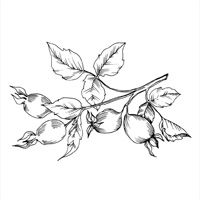
YOUR NATURAL PROTECTIVE SHIELD
A blend of vegetable oils, cold-pressed, unrefined:

sea buckthorn fruit oil

blackcurrant seed oil

rosehip seed oil
AntiOx+ Formula
VITAMIN E

Author of the recipe
AntiOx+ Formula
„AntiOx+ Formula is a real gem for functional oils lovers. The product formula is composed exclusively of cold-pressed oils characterised by a unique content of valuable fatty acids, polyphenolic compounds and natural antioxidants. The combination of sea buckthorn fruit, blackcurrant seed and rosehip seed oils perfectly meets the needs of a sensitive digestive system and skin and hair in need of intensive care and nourishment.”

DOKTOR MIKROBIOM
THE POWER OF NATURE IN ONE BOTTLE

Supporting the protective functions of the intestinal ecosystem

Supporting the treatment of stomach and intestinal diseases

Protection against oxidative stress

Supporting the condition of thin and sparse hair

Complex nourishment of sensitive skin with signs of ageing
Price from 69 zł
Capacity: 250 ml or 100 ml
Unrefined
Cold pressed
Balanced

COMPOSITION OF OIL AntiOx+ Formula
Sea-buckthorn fruit oil
Sea-buckthorn fruit oil is an abundant source of both monounsaturated and polyunsaturated fatty acids. In its composition, it contains up to 18% oleic acid, 3-4.5% α-linolenic acid and 33-38% oleo palmitoleic acid, which is rarely found in nature. The strong antioxidant properties of sea buckthorn oil, valued especially in cosmetology, are attributed to the flavonoids, phenolic acids, tocopherols and carotenoids found in it. The later ones, which are mainly present in the flesh of the fruit, also provide the extremely intense colouring of sea buckthorn oil. Because of this abundance and variety of compounds with antioxidant properties, sea buckthorn oil is an excellent antioxidant, widely used in anti-ageing therapies to suppress the symptoms of civilisation stressors on skin tissue. In addition, sea buckthorn oil is used in the treatment of certain disorders of stomach and intestinal function. It has anti-inflammatory effects, speeds up the healing processes of damage to the digestive tract mucosa and supports the renewal of the mucus layer. In addition, polyphenolic compounds, present in all parts of sea buckthorn, are responsible for its strong anti-pathogenic and prebiotic properties in the intestinal environment. In AntiOx+ Formula, sea buckthorn fruit oil makes up 55% of the blend.
Blackcurrant seed oil
Blackcurrant seed oil, constituting as much as 35% of AntiOx+ Formula, deserves special attention. It is one of the richest known sources of gamma-linolenic acid (GLA), while being rich in omega-3 fatty acids: α-linolenic acid (ALA) and stearidonic acid (one of the few vegetable oils!), matching fish oils in this aspect. In addition, blackcurrant seed oil is one of the richest in vitamin E among vegetable oils. It also contains phytosterols and the already mentioned carotenoids, flavonoids and phenolic acids. Due to these factors, blackcurrant seed oil is characterised by exceptionally strong antioxidant and anti-inflammatory properties, used to improve the condition of sensitive, dry, flaky skin in need of comprehensive support. Its cosmetic action in the problem of thin and sparse hair appears to be particularly promising. Studies suggest its beneficial effects in inhibiting hair loss and nourishing hair. Undoubtedly, blackcurrant oil, due to its unique fatty acid composition and the abundance of so many biologically active compounds, should be regarded as an oil of particular importance in health terms.
Rosehip seed oil
Rosehip seed oil constitutes 10 % of the AntiOx+ Formula composition. The oil consists mainly of essential fatty acids and valuable lipophilic antioxidants, especially γ- and δ-tocopherol, as well as the carotenoids β-carotene and lycopene, which are substances with very good bioavailability to the body. In the work of Rutkowska and co-workers, rosehip oil, next to linseed oil, was the richest source of polyunsaturated fatty acids of the omega-3 group. Moreover, this oil was also characterised by the most favourable ratios of fatty acids from the omega-6 to omega-3 family (similarly to the aforementioned linseed oil). Rosehip oil is also distinguished by its exceptionally rich content of anti-inflammatory and antioxidant polyphenolic compounds, so it could not be missing from this composition.
PERFECT ADDITION TO:

MUSLI

YOGURTS

SALADS
THIS IS WHAT YOU NEED TO KNOW
Ingredients
Sea-buckthorn fruit oil (Hippophae rhamnoides L.) 55 %.
Blackcurrant seed oil (Ribes nigrum L.) 35%.
Rosehip seed oil (Rosa canina L.) 10 %.
Made in Poland.
Nutritional values

Carotenoids: 150 mg/100ml
Vitamin E:
150 mg (1250 %*) / 100 ml
15 mg (125 %*) / 10 ml
* Daily reference intake value for the average adult.
Vitamin E helps to protect cells from oxidative stress.
How to use?
We recommend taking AntiOx+ Formula only with a meal. The product can be eaten alone or added to salads, coleslaw, dressings, smoothies and other dishes served only cold.
SHAKE BEFORE USE.
Storage
Store in a cool, dry and shaded place. Once opened, keep in the refrigerator. Best to consume within 2 months from the date of opening, no later than the date of minimum durability. Sediment at the bottom of the bottle is a natural phenomenon.
Additional notes
Due to the intense color of the oil, you should be especially careful as it may cause stains that are difficult to remove.
Science publications
- Kishimoto S, Maoka T, Sumitomo K, Ohmiya A. Analysis of carotenoid composition in petals of Calendula (Calendula officinae L.). Bioscience, Biotechnology and Biochemistry 2005, vol. 69(11): 2118-2122.
- Kruczek M, Świderski A, Mech-Nowak A, Król K. Antioxidant capacity of crude extracts containing carotenoids from the berries of various cultivars of sea buckthorn (Hippophaë rhamnoides L.). Acta Biochimica Polonica 2012, vol. 59(1): 135-137.
- Andersson SC, Olsson ME, Johansson E, Rumpunen K. Carotenoids in sea buckthorn (Hippophaë rhamnoides L.) berries during ripening and use of pheophytin as a maturity marker. Journal of Agricultural and Food Chemistry 2009, vol. 57(1): 250-258.
- Patel CA, Divakar K, Santani D, Solanki HK, Thakkar JH. Remedial Prospective of Hippophae rhamnoides Linn. (Sea Buckthorn). ISRN Pharmacol. 2012
- Zakynthinos G, Varzakas T. Hippophae Rhamnoides: Safety and Nutrition. Current Research in Nutrition and Food Science Journal 2015.
- Cakir A. Essential oil and fatty acid composition of the fruits of Hippophaë rhamnoides L. (Sea Buckthorn) and Myrtus communis L. from Turkey. Biochemical Systematics and Ecology 2004, vol. 32: 809-816.
- Beveridge T, Li TSC, Oomah BD, Smith A. Sea buckthorn products: manufacture and composition. Journal of Agricultural and Food Chemistry 1999, vol. 47: 3480-3488.
- Lamer-Zarawska E., Chwała C., Gwardys A.: Rośliny w kosmetyce i kosmetologii przeciwstarzeniowej. Wydawnictwo Lekarskie PZWL, Warszawa 2012.
- Michalak M, Paradowska K, Zielińska A. Możliwości wykorzystania w kosmetologii wybranych olejów roślinnych jako źródła karotenoidów. Postępy Fitoterapii 2018, vol. 19(1): 10-17.
- Bojarowicz H., Woźniak B.: Wielonienasycone kwasy tłuszczowe oraz ich wpływ na skórę. Probl. Hig. Epidemiol. 2008, 89, 471–475
- Białecki J., Skalski B., Olas B.: Rokitnik zwyczajny [Elaeagnus rhamnoides (L.) A. Nelson] jako źródło związków prozdrowotnych. Problemy Nauk Biologicznych, 1/2021.
- Zadernowski R., Piłat B.: Preparations of sea buckthorn berries in the prevention and therapy of some geriatric diseases – the current state of research. Post Fitoter 2021; 22(2): 97-105
- Suryakumar G., Gupta A.: Medicinal and therapeutic potential of sea buckthorn (Hippophaë rhamnoides L.). J Ethnopharmacol 2011; 138:268-78.
- Piłat B, Bieniek A, Zadernowski R. Common sea buckthorn (Hippophae rhamnoides L.) as an alternative orchard plant. Pol J Natur Sc 2015; 30(4):417-30.
- Xu M, Sun S, Cui J. The medicinal research on sea buckthorn. Proc Int Workshop Seabuckthorn. New Delhi, India 2001; (2):18-21.
- Piłat B. Owoce rokitnika (Hippophaë rhamnoides L.) jako źródło substancji biologicznie aktywnych. Praca doktorska. Bibioteka UWM Olsztyn 2013.
- Olas B. Sea buckthorn as a source of important bioactive compounds in cardiovascular diseases. Food Chem Toxicol 2016; 97:199-204.
- Yadav A, Stobdan T, Chauhan OP i wsp. Sea Buckthorn: A multipurpose medicinal plant from Upper Himalayas. W: Joshee N, Dhekney S, Parajuli P (eds). Medicinal Plants 2019; 399-426.
- Kumar R, Kumar GP, Chaurasia OP, Singh BS. Phytochemical and pharmacological profile of sea buckthorn oil. Research Journal of Medicinal Plant 2011, vol. 5: 491-499.
- Piłat B, Zadernowski R, Bieniek A. Charakterystyka chemiczna różnych odmian rokitnika. Bromat Chem Toksykol 2012; 45(3):897-901.
- Dogra et al. “Efficacy of Seabuckthorn (Hippophae Rhamnoides) Oil Vis-a-Vis Other Standard Drugs for Management of Gastric Ulceration and Erosions in Dogs.” Veterinary Medicine International, Hindawi Publishing Corporation, 2013.
- Teleszko M, Wojdyło A, Rudzińska M i wsp. Analysis of lipophilic and hydrophilic bioactive compounds content in sea buckthorn (Hippophaë rhamnoides L.) berries. J Agric Food Chem 2015; 63:4120-9.
- Tyagi N, Singh A, Kohli K. New insights towards implications of Sea Buckthorn Oil in Human Health. INJIRR 2018; 4, 5 (A):1204-8.
- Zielińska A, Nowak I. Abundance of active ingredients in sea-buckthorn oil. Lipids Health Dis 2017; 16:95.
- Otgonbayar C, Matthaus B, Odonmajig P. Fatty acid, tocopherol and sterol composition in Sea buckthorn (Hippophaë rhamnoides L.) of Mongolia. Mong J Chem 2011; 12(38):126-30.
- St George S, Cenkowski S. Influence of harvest time on the quality of oil-based compounds in sea buckthorn (Hippophaë rhamnoides L. ssp. sinensis) seed and fruit. J Agric Food Chem 2007; 55:8054-1.
- Burčová Z, Kreps F, Schmidt Š i wsp. Composition of fatty acids and tocopherols in peels, seeds and leaves of Sea buckthorn. Acta Chim Slov 2017; 10(1):29-34.
- Ulanowska K, Skalski B, Olsa B. Rokitnik zwyczajny (Hippophaë rhamnoides L) jako źródło związków o aktywności przeciwnowotworowej i radioprotekcyjnej. Post Hig Med Dośw 2018; 72:240-52
- Christaki E. Hippophae rhamnoides L. (sea buckthorn): A potential source of nutraceuticals. Food Public Health 2012; (2):69-72.
- Bośko P, Biel W. Therapeutic activity of sea buckthorn (Hippophaë rhamnoides L.). Post Fitoter 2017; 18(1): 36-41
- Olas B. The beneficial health aspects of sea buckthorn [Elaeagnus rhamnoides (L.) A. Nelson] oil. Journal of Ethnopharmacology 2018, vol. 1(213): 183-190.
- Manea AM, Ungureanu C, Meghea A. Effect of vegetable oils on obtaining lipid nanocarriers for sea buckthorn extract encapsulation. Comptes Rendus Chimie 2014, vol. 17(9): 934-943.
- Yang B, Kalimo KO, Tahvonen RL, Mattila LM, Katajisto JK, Kallio HP. Effect of dietary supplementation with sea buckthorn (Hippophaë rhamnoides) seed and pulp oils on the fatty acid composition of skin glycerophospholipids of patients with atopic dermatitis. Journal of Nutritional Biochemistry 2000, vol. 11(6): 338-340.
- Yamamoto Y, Kawamura Y, Yamazaki Y, Kijima T, Morikawa T, Nonomura Y. Palmitoleic Acid calcium salt: a lubricant and bactericidal powder from natural lipids. Journal of Oleo Science 2015, vol. 64(3): 283-288.
- Gęgotek A, Jastrząb A, Jarocka-Karpowicz I, Muszyńska M, Skrzydlewska E. The Effect of Sea Buckthorn (Hippophae rhamnoides L.) Seed Oil on UV-Induced Changes in Lipid Metabolism of Human Skin Cells. Antioxidants (Basel) 2018, vol. 7(9): 110.
- Zeb A, Mehmood S. Carotenoids contents from various sources and their potential health applications. Pakistan Journal of Nutrition 2004, vol. 3(3): 199-204
- Boca AN, Ilies RF, Saccomanno J, Pop R, Vesa S, Tataru AD, Buzoianu AD. Sea buckthorn extract in the treatment of psoriasis. Experimental and Therapeutic Medicine 2019, vol. 17(2): 1020-1023. 26.
- Tkacz K, Wojdyło A et al. Anti-oxidant and anti-enzymatic activities of sea buckthorn (Hippophaë rhamnose) fruits modulated by chemical components. Antioxidants (2019) 8: 1-17. 4.
- Marsinach MS and Cuenca AP. The impact of sea buckthorn oil fatty acids on human health. Lipids Health Dis. (2019) 18: 1-11.
- Rachtan-Janicka J., Ponder A., Hallmann E. The Effect of Organic and Conventional Cultivations on Antioxidants Content in Blackcurrant (Ribes nigrum L.) Species. Appl. Sci. 2021;11:5113.
- Pieszka M., Migdał W., Gąsior R. et al. Native oils from apple, blackcurrant, raspberry, and strawberry seeds as a source of polyenoic fatty acids, tocochromanols, and phytosterols: A health implication. J. Chem. 2015;2015:659541.
- Trela A., Szymańska R. Less widespread plant oils as a good source of vitamin E. Food Chem. 2019;296:160–166.
- Jurgoński A., Fotschki B., Juśkiewicz J. Disparate metabolic effects of blackcurrant seed oil in rats fed a basal and obesogenic diet. Eur. J. Nutr. 2015;54:991–999.
- Linnama P., Nieminen K., Koulu L. et al. Black currant seed oil supplementation of mothers enhances IFN-c and suppresses IL-4 production in breast milk. Pediatr. Allergy Immunol. 2013;24:562–566.
- Linnamaa P., Savolainen J., Koulu L. et al. Blackcurrant seed oil for prevention of atopic dermatitis in newborns: A randomized, double-blind, placebo-controlled trial. Clin. Exp. Allergy. 2010;40:1247–1255.
- Zhao F., Wu Z., Hou Y. et al. Efficacy of blackcurrant oil soft capsule, a Chinese herbal drug, in hyperlipidemia treatment. Phytother. Res. 2010;24:S209–S213.
- Deferne J.L., Leeds A.R. Resting blood pressure and cardiovascular reactivity to mental arithmetic in mild hypertensive males supplemented with blackcurrant seed oil. J. Hum. Hypertens. 1996;10:531–537.
- Tahvonen RL, Schwab US, Linderborg KM et al. Black currant seed oil and fish oil supplements differ in their effects on fatty acid profiles of plasma lipids, and concentrations of serum total and lipoprotein lipids, plasma glucose and insulin. J Nutr Biochem. 2005 Jun;16(6):353-9.
- Mińkowski K, Grześkiewicz S, Jerzewska M. Ocena wartości odżywczej olejów roślinnych o dużej zawartości kwasów linolenowych na podstawie składu kwasów tłuszczowych, tokoferoli i steroli. Żywn Nauk Technol Jakość 2011, 2: 124-135.
- Šavikin KP, Ðorđević BS, Ristić MS, et al. Variation in the fatty-acid content in seeds of various black, red, and white currant varieties. Chem Biodivers 2013, 10(1): 157-165.
- Leventhal LJ, Boyce EG, Zurier RB. Treatment of rheumatoid arthritis with blackcurrant seed oil. Rheumatology 1994, 33(9): 847-852.
- Wu D, Meydani M, Leka LS, et al. Effect of dietary supplementation with blackcurrant seed oil on the immune response of healthy elderly subjects. Am J Clin Nutr 1999, 70: 536-543.
- Grajzer M. Study of the biologically active constituents content and oxidative stability of some cold-pressed oils. Rozprawa doktorska, Wrocław 2015.
- Rutkowska J, Antoniewska A, Baranowski D, Rasińska E. Analiza profilu kwasów tłuszczowych wybranych olejów „nietypowych”. Bromat. Chem. Toksykol. 2016.
- Milala J, Sójka M, Król K, Buczek M. Charakterystyka składu chemicznego owoców Rosa pomifera „Karpatia”. Nauka. Technologia. Jakość, 2013, 5 (90), 154 – 167.
- Łoźna K, Kita A, Styczyńska M, Biernat J. „Fatty acid composition of oils recommended in the prevention of lifestyle diseases”. Probl Hig Epidemiol 2012, 93(4): 871-875
- Adamczak A., Buchwald W., Zieliński J., Mielcarek S.: Flavonoid and organic acid content in rose hips (Rosa L., sect. Caninae dc. Em. Christ.). Acta Biol. Cracov., Ser. Bot. 2012, 54, 1, 1-8.
- Chrubasik C, Roufogalis B D, Müller-Ladner U, Chrubasik S (2008). A systematic review on the Rosa canina effect and efficacy profiles. Phytotherapy Research, 22(6), 725–733.
- Ercisli S, Orhan E, Esitken A (2007). Fatty acid composition of Rosa species seeds in Turkey. Chemistry of Natural Compounds, 43(5), 605–606.
- Fromm M, Bayha S., Kammerer D R, Carle R (2012). Identification and quantitation of carotenoids and tocopherols in seed oils recovered from different Rosaceae species. Journal of Agricultural and Food Chemistry, 60(43), 10733–10742.